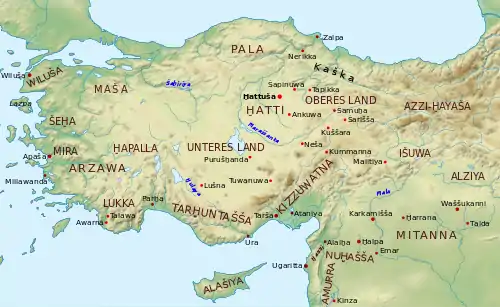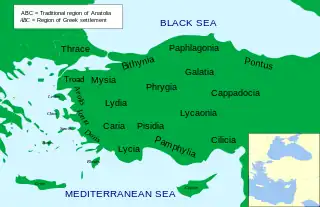| History of Turkey |
|---|
 |
| Timeline |
|
|



This is a list of peoples who inhabited Anatolia in antiquity. The essential purpose of the list is to identify prehistoric cultures in the region but many of the peoples continued to inhabit Anatolia into and through classical and late antiquity, so the actual scope of the list encompasses the history of Anatolia from prehistory to the Eastern Roman Empire (4th to 7th centuries AD), during which transition to the early medieval occurred.
Anatolia was inhabited by numerous races and its history is characterised by folk movement and migration. Broadly, the peoples can be split linguistically between those who spoke a proto-Indo-European language, such as proto-Anatolian or proto-Greek, and those who spoke a language outside of the Indo-European family such as Kartvelian or Kaskian. The Indo-Europeans are further sub-divided into those who may be termed Anatolian natives and those whose origins were elsewhere. Native Anatolians included the Hittites, Luwians and the Lydians; incoming races included the Armenians, Greeks, Phrygians and Thracians.
Indo-European peoples
Anatolian peoples (Anatolian Indo-European)
Hittites
- Cappadocians? / Leucosyri? (Cappadocians and Leucosyri were the same people; Cappadocians was the Persian name and Leukosyroi the Greek name, Leucosyri is the Latin name based on Greek) (Cappadocians also inhabited the West Pontus that originally was part of Cappadocia)
- Amiseni? (inhabited Themiscyra district in West Pontus)
- Kases? / Cases?
- Cataonians?
Luwians
- Carians
- Cilicians
- Isaurians
- Leleges?
- Lycaonians
- Lycians
- Philistines? - notably inhabited Palestine; their inclusion here is tenuous as they may have had an Anatolian origin
- Pisidians / Pamphylians (Pamphylians, on the coast, and Pisidians, in the inland, were the same people and spoke the same language, the difference was that Anatolian Pamphylians were more Greek influenced since Iron Age) (there was an Anatolian Pamphylian dialect, part of the Pisidian language, and a Pamphylian Greek dialect, part of Ancient Greek, depending on the degree of Hellenization)
- Sidians
- Solymoi / Solymi
- Telchines?
Western Anatolian
- Lydians
- Kaystrianoi / Caystriani
- Kilbianoi / Cilbiani
Palaic peoples
- Paphlagonians?
- Caucones? / Kaukauni?
- Heneti?
- Mariandyni?
Possible Anatolian (Indo-European) peoples
- Mysians? (possibly they were more related to the Phrygians, a non Anatolian Indo-European people, and therefore they were possibly not an Anatolian Indo-European people, Mysia was also known as Phrygia Hellespontica, however they probably had a mixing with an Anatolian people closer to the Lydians that would explain contradictory statements by ancient authors)
- Milatai? / Milatae?
- Isuwans? (seem to have been a mixed Anatolian, Hurrian, and Mitanni population)
Armenians
Celts
Galatians
- Tectosages
- Tolistobogii / Tolistobogioi
- Trocmi / Trokmoi
- Aigosages, between Troy and Cyzicus
- Daguteni, in modern Marmara region around Orhaneli
- Inovanteni, east of the Trocnades
- Okondiani, between Phrygia and Galatia northeast of modern Akşehir Gölü
- Rigosages, unlocated
Greeks
Phrygians
- Kaourkoi / Caurci?
- Fontes?
Mysians
- Mysians (possibly they were more related to the Phrygians, a non Anatolian Indo-European people, and therefore they were possibly not an Anatolian Indo-European people, Mysia was also known as Phrygia Hellespontica, however they probably had a mixing with an Anatolian people closer to the Lydians that would explain contradictory statements by ancient authors)
- Milatai? / Milatae?
Thracians
Bithynians
Thynians
Possible Indo-European peoples
Hayasa-Azzi
Mushki
- Mushki
- Western Mushki (synonymous of the Phrygians? and related Mysians?)
- Eastern Mushki (Proto-Armenians?)
- Moschi-Mossynoeci
- Moschi (possible Mushki, Indo-European?, origin, assimilated by old Kartvelian peoples and named Meskhetians, the inhabitants of Meskheti in far southwestern Georgia - Sakartvelo)
- Mossynoeci (possible Mushki, Indo-European?, origin, assimilated by old Kartvelian peoples and named Meskhetians, the inhabitants of Meskheti in far southwestern Georgia - Sakartvelo)
- Moschi-Mossynoeci
Urumu
- Urumu (Proto-Armenians?), allied with Mushki and Kaskians, possibly Arimi of Greek sources and Arme/Urme/Armini of Urartian sources
Tibareni
Diauehi
- Mentioned by Assyrians as one of the Nairi tribes inhabiting the Palu or Mush regions, later mentioned by Urartians in the vicinity of Kars Province, probably the Taochoi of Greek sources
Non-Indo-European peoples
Kartvelians
Colchians
- Byzeres (The name of the historical region Odzrkhe is derived from the name of this tribe - Vidzerukh / Viterukh / Odzr(a)khe / Odzrkhe)
- Drilae / Sanni
- Machelones-Macrones
- Machelones (closely related to the Macrones)
- Macrones (ancestors of present-day Mingrelians)
- Marres
- Phasians
- Zydretae
Possible Kartvelian peoples
Eastern Mushki
- Moschi-Mossynoeci
- Moschi (possible Mushki, Kartvelian?, origin, and named Meskhetians, the inhabitants of Meskheti in far southwestern Georgia - Sakartvelo)
- Mossynoeci (possible Mushki, Kartvelian?, origin, and named Meskhetians, the inhabitants of Meskheti in far southwestern Georgia - Sakartvelo)
Tibareni
Hurrians
- Mitanni (seem to have been Hurrian with an Indo-Aryan ruling class)
- Isuwans (seem to have been a mixed Anatolian, Hurrian, and Mitanni population)
- Kizzuwatnans
- Urartu (predecessors of the Armenians, they spoke a language similar to Hurrians)
Linguistically unclassified peoples
Hattians
The Hattians occupied the land of Hatti in central Anatolia and are documented at least as early as the empire of Sargon of Akkad (c. 2300 BC).[1] Possibly connected to Northwest Caucasians.
Kaskians
Possibly connected to Hattians and/or Northwest Caucasians.
See also
References
- ↑ Trevor Bryce, The Kingdom of the Hittites: New Edition, Oxford University Press, 2005. p.12
Further reading
- Steadman, Sharon R.; McMahon, Gregory (2011). The Oxford Handbook of Ancient Anatolia: (10,000-323 BCE). Oxford University Press. ISBN 978-0195376142.